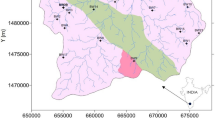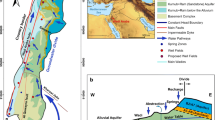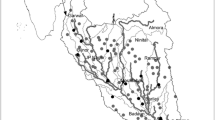Abstract
Realistic assessment and prediction of groundwater resources, at appropriate scales, are crucial for proper management and systematic development of groundwater in India. An equivalent porous medium (EPM)-based groundwater flow model is implemented for a typical hard-rock aquifer in central India, to provide quantification, analysis and prediction of groundwater balance components. This research also provides refined estimates of aquifer parameters, recharge factors and newer insights into groundwater dynamics. It is observed that evaporative losses and effluent seepage of groundwater to rivers jointly account for ~20% of the annual recharge, which is significantly higher than most prior regional assessments. Evaluation of groundwater resource use under a business-as-usual scenario shows annual groundwater draft to exceed recharge by 13% in the year 2020–2021, and under a worst-case scenario (with prevailing drought conditions) this deficit is predicted to increase to 30%. However, with suitable recharge augmentation and demand control measures, in the best-case scenario, groundwater draft can be contained to ~90% of annual recharge, thereby ensuring long-term sustainability of groundwater resources. Importantly, this study reveals that demand control measures can be more effective than recharge augmentation measures.
Résumé
Une évaluation et une prévision réalistes des ressources en eaux souterraines, à des échelles appropriées, sont cruciales pour une bonne gestion et une exploitation systématique des eaux souterraines en Inde. Un modèle d’écoulement des eaux souterraines basé sur un milieu poreux équivalent (MPE) est mis en œuvre pour un aquifère typique de contexte de socle du centre de l’Inde, afin de fournir une quantification, analyse et prévision des composants du bilan des eaux souterraines. Cette recherche fournit également des estimations raffinées des paramètres de l’aquifère, des facteurs de recharge et de nouvelles informations sur la dynamique des eaux souterraines. Il a été observé que les pertes par évaporation et l’écoulement d’eaux souterraines par suintement vers les rivières représentent ensemble ~20% de la recharge annuelle, ce qui est nettement supérieur à la plupart des évaluations régionales antérieures. L’évaluation de l’utilisation des ressources en eaux souterraines dans le cas d’un scénario de statu quo montre que le prélèvement des eaux souterraines excédera la recharge de 13% pour les années 2020–2021, et dans le cas d’un scénario le plus pessimiste (avec des conditions de sécheresses prépondérantes), ce différentiel devrait atteindre 30%. Cependant, avec une augmentation appropriée de la recharge et des mesures de contrôle de la demande en eau, dans le meilleur des cas, le prélèvement des eaux souterraines pourrait correspondre à environ 90% de la recharge annuelle, assurant ainsi la durabilité à long terme des ressources en eaux souterraines. Surtout, cette étude révèle que les mesures de contrôle de la demande peuvent être plus efficaces que les mesures d’augmentation de la recharge.
Resumen
La evaluación y la predicción realistas de los recursos hídricos subterráneos, a las escalas apropiadas, son cruciales para una adecuada gestión y un desarrollo sistemático de las aguas subterráneas en la India. Se aplica un modelo de flujo subterráneo basado en el medio poroso equivalente (EPM) para un acuífero típico de roca dura en la India central, con el fin de cuantificar, analizar y predecir los componentes del balance de las aguas subterráneas. Esta investigación también proporciona estimaciones precisas de los parámetros del acuífero, los factores de recarga y nuevos conocimientos sobre la dinámica de las aguas subterráneas. Se observa que las pérdidas por evaporación y por la efluencia de las aguas subterráneas hacia los ríos representan ~20% de la recarga anual, lo que es significativamente mayor que la mayoría de las evaluaciones regionales anteriores. La evaluación del uso de los recursos de aguas subterráneas en una hipótesis sin cambios muestra que la extracción anual superará la recarga en un 13% en el año 2020-2021, y en la hipótesis más desfavorable (con condiciones de sequía imperantes) se prevé que este déficit aumente hasta el 30%. Sin embargo, con un aumento adecuado de la recarga y medidas de control de la demanda, en el mejor de los casos, la extracción de agua subterránea puede contenerse hasta ~90% de la recarga anual, asegurando así la sostenibilidad a largo plazo de los recursos hídricos subterráneos. Es importante señalar que este estudio revela que las medidas de control de la demanda pueden ser más eficaces que las medidas de aumento de la recarga.
摘要
适宜尺度上的地下水资源现状评估和预测, 对于印度正确管理和系统开发地下水至关重要。针对印度中部典型的硬岩含水层, 开发了基于等效多孔介质(EPM)的地下水流模型, 以此对地下水均衡成分进行定量化, 分析和预测。这项研究还进行了含水层参数和补给系数的精细估计以及对地下水动力机制的最新见解。据研究观测, 蒸发损失和地下水向河流的渗漏共同构成了年补给量的约20%, 大大高于大多数先前的区域评估结果。正常情景下地下水资源评价表明, 到2020年至2021年, 每年的地下水消耗量将超过补给量的13%, 在最坏情况下(持续干旱情景), 预计地下水的赤字将增加到30%。然而, 通过适宜的补给增加和需求控制措施, 在最佳情况下, 可以将地下水消耗控制在年补给量的90%左右, 以此将确保地下水资源的长期可持续性。重要的是, 本研究表明, 需求控制措施可能比补给措施更为有效。
Resumo
A avaliação realista e a previsão dos recursos hídricos subterrâneos, em escalas apropriadas, são cruciais para o gerenciamento adequado e o desenvolvimento sistemático das águas subterrâneas na Índia. Um modelo de fluxo baseado em água subterrânea em meio poroso equivalente (MPE) é implementado para um aquífero de rocha cristalina típico no centro da Índia, para fornecer quantificação, análise e previsão de componentes do equilíbrio da água subterrânea. Esta pesquisa também fornece estimativas refinadas dos parâmetros do aquífero, fatores de recarga e informações mais recentes sobre a dinâmica das águas subterrâneas. Observa-se que as perdas por evaporação e a infiltração de efluentes das águas subterrâneas nos rios representam conjuntamente ~ 20% da recarga anual, o que é significativamente maior do que a maioria das avaliações regionais anteriores. A solução de avaliação do uso de recursos de águas subterrâneas em um cenário de negócios usual mostra que a retirada anual de águas subterrâneas excede em 13% a recarga no ano 2020-2021 e, no pior cenário (com condições de seca prevalecentes), esse déficit deve aumentar 30% No entanto, com medidas adequadas de aumento da recarga e controle de demanda, no melhor dos casos, a corrente de água subterrânea pode ser contida em ~ 90% da recarga anual, garantindo assim a sustentabilidade a longo prazo dos recursos de água subterrânea. É importante ressaltar que este estudo revela que medidas de controle de demanda podem ser mais eficazes que medidas de aumento de recarga.













Similar content being viewed by others
References
Abbo H, Shavit U, Markel D, Rimmel A (2003) A numerical study on the influence of fractured regions on lake/groundwater interaction: the Lake Kinneret (Sea of Galilee) case. J Hydrol 283:225–243. https://doi.org/10.1016/S0022-1694(03)00273-7
Ahmad I, Umar R (2009) Groundwater flow modelling of Yamuna-Krishni intersection, a part of central Ganga plain, Uttar Pradesh. J Earth Syst Sci 118(5):507–523
Ahmed S, Engerrand C, Sreedevi PD, Kumar D, Subrahmanyam K, Ledoux E, Marsily G (2003) Geostatistics, aquifer modeling and artificial recharge, scientific report: volume 3, indo-French collaborative project (2003-1). Technical report NGRI-2003-GW-41, NGRI, Hyderabad, India
Alam F, Umar R (2013) Groundwater flow modelling of Hindon-Yamuna interfluve region, western Uttar Pradesh. J Geol Soc India 82:80–90. https://doi.org/10.1007/s12594-013-0113-8
Anderson MP, Woessner WW (1992) Applied groundwater modeling, simulation of flow and advective transport. Academic, New York
Anon (2008) Comprehensive mission document, vol 2. National Water Mission under the National Action Plan on Climate Change, Ministry of Water Resources, Govt. of India, 471 pp. http://wrmin.nic.in/writereaddata/nwm28756944786.pdf. Accessed 17 November 2017
CGWB (2006a) State report: hydrogeology of Chhattisgarh. Central Ground Water Board, North Central Chhattisgarh Region (NCCR), Raipur, India, 184 pp
CGWB (2006b) Dynamic ground water resources of India (as on March 2004). Central Ground Water Board, Ministry of Water Resources, Govt. of India. http://cgwb.gov.in/Documents/Dynamic-GW-Resources-2004.pdf. Accessed 17 November 2017
CGWB (2011) Dynamic ground water resources of India (as on March 2009). Central Ground Water Board, Ministry of Water Resources, Govt. of India. http://cgwb.gov.in/Documents/Dynamic-GW-Resources-2009.pdf. Accessed 17 November 2017
CGWB (2012) Aquifer systems of Chhattisgarh, North Central Chhattisgarh Region. Central Ground Water Board, Ministry of Water Resources, Govt. of India. http://cgwb.gov.in/AQM/Chhattisgarh.pdf. Accessed 17 November 2017
CGWB (2013) Master plan for artificial recharge to ground water in India. Central Ground Water Board, Ministry of Water Resources, Govt. of India. Accessed 17 November 2017
CGWB (2014) Dynamic ground water resources of India (as of 31st March 2011). Central Ground Water Board, Ministry of Water Resources, Govt. of India. http://cgwb.gov.in/Documents/Dynamic-GW-Resources-2011.pdf. Accessed 17 November 2017
CGWB (2017a) Dynamic ground water resources of India (as of 31st March 2013). Central Ground Water Board, Ministry of Water Resources, Government of India. http://cgwb.gov.in/Documents/Dynamic-GW-Resources-2011.pdf. Accessed 17 November 2017
CGWB (2017b) Report of the ground water resource estimation committee (GEC 2015): methodology. Ministry of Water Resources, River Development and Ganga rejuvenation, Govt. of India. http://cgwb.gov.in/Documents/GEC2015_Report_Final%2030.10.2017.pdf. Accessed 17 November 2017
CGWB (2019) National compilation on dynamic ground water resources of India 2017. Central Ground Water Board, Department of Water Resources, River Development and Ganga Rejuvenation, Ministry of Jal Shakti, Government of India. http://cgwb.gov.in/GWAssessment/GWRA-2017-National-Compilation.pdf. Accessed 28 February 2020
Chandraprakash (2017) Studies on drought in Kharun sub basin for supplemental irrigation planning of kharif crops. MSc Thesis, Indira Gandhi Krishi Vishwavidyalaya, Raipur, India, 120 pp. www.krishikosh.egranth.ac.in/bitstream/1/5810035227/1/thesis.pdf. Accessed 17 November 2017
Chatterjee R, Ray RK (2016) A proposed new approach for groundwater resources assessment in India. J Geol Soc India 88(3):357–365. https://doi.org/10.1007/s12594-016-0498-2
Das DP, Kundu A, Dutta DR, Kumaran K, Ramamurthy S, Thanavelu C, Ragaiya V (1992) Lithostratigraphy and sedimentation of Chhattisgarh basin. Indian Mineral 46(3–4):271–288
DWAF (2006) Methodology for groundwater quantification. GRA II Task: 1A, 1BC, 1D. Department of Water Affairs and Forestry, Pretoria, South Africa
Famiglietti JS (2014) The global groundwater crisis. Nat Clim Chang 4:945
FAO (2016) AQUASTAT main database, food and agriculture organization of the United Nations (FAO). http://www.fao.org/nr/water/aquastat/data/query/index.html?lang=en. Accessed Feb 2020
Ford DC, Williams PW (2007) Karst hydrogeology and geomorphology. Wiley, Chichester, UK
Gallegos JJ, Hu BX, Davis H (2013) Simulating flow in karst at laboratory and sub-regional scales using MODFLOW-CFP. Hydrogeol J 21:1749–1760. https://doi.org/10.1007/s10040-013-1046-4
Gleeson T, Smith L, Moosdorf N, Hartman J, Dürr Manning AH, van Beek PH, Jellinek AM (2011) Mapping permeability over the surface of the earth. Geophys Res Lett 46:L02401. https://doi.org/10.1029/2010GL045565
Gonzalez-Herrera R, Sanchez-y-Pinto I, Gamboa-Vargas J (2002) Groundwater-flow modeling in Yucatan karstic aquifer, Mexico. Hydrogeol J 10:539–552
Gupta AK, Tyagi P, Sehgal VK (2011) Drought disaster challenges and mitigation in India: strategic appraisal. Curr Sci 100(12):1795–1806 http://www.currentscience.ac.in/volumes/100/12/1795.pdf. Accessed 17 November 2017
Harbaugh AW, Banta ER, Hill MC, McDonald MG (2000) MODFLOW 2000, the US Geological Survey modular groundwater model: user guide to modularisation concepts and groundwater flow process. US Geol Surv Open-File Rep 00-92, 121 pp
Huntoon PW (1994) Is it appropriate to apply porous media groundwater circulation models to karstic aquifers? In: El-Kadi AI (ed) Groundwater models for resources analysis and management. Pacific Northwest/Oceania Conference, Honolulu, HI, pp 339–358
IMD (2020) Glossary. India Meteorological Department (IMD), Pune. http://www.imdpune.gov.in/Weather/Reports/glossary.pdf. Accessed 11 January 2020
Kaehler CA, Hsieh PA (1994) Hydraulic properties of a fractured-rock aquifer, Lee Valley, San Diego County, California. US Geol Surv Water Suppl Pap 2394, 64 pp
Kansal ML, Chandniha SK, Tyagi A (2015) Distance based water sustainability assessment using SPI for the state of Chhattisgarh in India. In: Karvazy PE, Webster VL (ed) World Environmental and Water Resources Congress 2015: Floods, Droughts, and Ecosystems, Austin, TX, May 2015
Khare MC (1981) Sedimentological and hydrogeological studies of parts of Durg and Raipur districts, M.P., India. PhD Thesis, University of Roorkee, India, 351 pp
Kumar N (2014) Impacts of climate change and land-use change on the water resources of the Upper Kharun Catchment, Chhattisgarh, India. PhD Thesis, Rheinischen Friedrich-Wilhelms-Universitätzu Bonn, Germany. http://hss.ulb.uni-bonn.de/diss_online.Cited. Accessed 18 June 2017
Kumar T, Gautam AK (2014) Appraising the accuracy of GIS based multicriteria decision making technique for delineation of groundwater potential zones. Water Resour Manag 28(13):4449–4466
Kushwaha RK, Pandit MK, Goyal R (2009) MODFLOW based groundwater resource evaluation and prediction in Mendha sub-basin, NE Rajasthan. J Geol Soc India 74:449–458
Langevin CD (2003) Simulation of submarine ground water discharge to a marine estuary: Biscayne Bay, Florida. Groundwater 41(6):758–771
MoWR (2009) Ground water resource estimation methodology. Report, Ground Water Resource Estimation Committee, Ministry of Water Resources, Govt. of India, 107 pp. http://cgwb.gov.in/documents/gec97.pdf. Accessed 17 November 2017
Mukherjee A, Fryar AE, Howell PD (2007) Regional hydrostratigraphy and groundwater flow modeling in the arsenic-affected areas of the western Bengal basin, West Bengal. Hydrogeol J 15(7):1397–1418. https://doi.org/10.1007/s10040-007-0208-7
Mukherjee A, Ray RK, Tewari D, Ingle VK, Sahoo BK, Khan MWY (2014) Revisiting the stratigraphy of the Mesoproterozoic Chhattisgarh Supergroup, Bastar craton, India based on subsurface lithoinformation. J Earth Syst Sci 123(3):617–632
Narasimhan TN (2008) A note on India’s water budget and evapotranspiration. J Earth Syst Sci 117(3):237–240
Neuman SP (1987) Stochastic continuum representation of fractured rock permeability as an alternative to the REV and fracture network concepts. In: Custodio E, Gurgui A, Lobo-Ferreira JP (eds) NATO advanced workshop on advances in analytical and numerical groundwater flow and quality modelling. In: NATO ASI Series C: mathematical and physical sciences, vol 224. Reidel, Dordrecht, The Netherlands, pp 331–362
NRC (1996) Rock fractures and fluid flow: contemporary understanding and applications. USA National Research Council (NRC), National Academic Press, Washington, DC, 551 pp
NRSC (2013) Thematic map of land use and land cover (250K) for the year 2012–13. http://bhuvan.nrsc.gov.in/gis/thematic/index.php. Accessed February 2020
Panagopoulos G (2012) Application of MODFLOW for simulating groundwater flow in the Trifilia karst aquifer, Greece. Environ Earth Sci 67:1877–1889. https://doi.org/10.1007/s12665-012-1630-2
Pankow JF, Johnson RL, Hewetson JP, Cherry JA (1986) An evaluation of contaminant migration patterns at two waste disposal sites on fractured porous media in terms of the equivalent porous medium (EPM) model. J Contaminant Hydrol 1:65–76
Patranabis-Deb S, Chaudhuri AK (2002) Stratigraphic architecture of the Proterozoic succession in the eastern Chattisgarh Basin, India: tectonic implications. Sediment Geol 147:105–125
Quinlan JF, Davies GJ, Jones SW, Huntoon PW (1996) The applicability of numerical models to adequately characterize groundwater flow in karstic and other triple-porosity aquifers. In: Ritchy JD, Rumbaugh JO (eds) Subsurface fluid-flow (ground-water and vadose zone) Modeling. ASTM STP 1288, American Society for Testing and Materials, West Conshohocken, PA, pp 114–133
Ray RK, Mukherjee A, Mukherjee R (2014) Estimation of specific yields of individual litho-units in a terrain with multiple litho-units: a water balance approach. J Geol Soc India 84(2):221–225. https://doi.org/10.1007/s12594-014-0126-y
Ray RK, Syed TH, Saha D, Sarkar BC, Patre AK (2017a) Assessment of village-wise groundwater draft for irrigation: a field-based study in hard-rock aquifers of central India. Hydrogeol J 25(8):2513–2525. https://doi.org/10.1007/s10040-017-1625-x
Ray RK, Syed TH, Saha D, Sarkar BC, Reddy DV (2017b) Recharge mechanism and processes controlling groundwater chemistry in a Precambrian sedimentary terrain: a case study from central India. Environ Earth Sci 76:136. https://doi.org/10.1007/s12665-017-6435-x
Rhode MM, Edmunds WM, Freyberg D, Sharma OP, Sharma A (2015) Estimating aquifer recharge in fractured hard rock: analysis of the methodological challenges and application to obtain a water balance (Jaisamand Lake Basin, India). Hydrogeol J 23:1573–1586. https://doi.org/10.1007/s10040-015-1291-9
Romanazzi A, Gentile F, Polemio M (2015) Modelling and management of a Mediterranean karstic coastal aquifer under the effects of seawater intrusion and climate change. Environ Earth Sci 74(1):115–128. https://doi.org/10.1007/s12665-015-4423-6
Sahoo S, Jha MK (2017) Numerical groundwater-flow modeling to evaluate potential effects of pumping and recharge: implications for sustainable groundwater management in the Mahanadi delta region, India. Hydrogeol J 25(2489):2489–2511. https://doi.org/10.1007/s10040-017-1610-4
Scanlon BR, Mace RE, Barrett ME, Smith B (2003) Can we simulate regional groundwater flow in a karst system using equivalent porous media models? Case study, Barton Springs Edwards aquifer, USA. J Hydrol 276:137–158. https://doi.org/10.1016/S0022-1694(03)00064-7
Schwarz FW, Smith L (1988) A continuum approach for modelling mass transport in fractured media. Water Resour Res 24(8):1360–1372
Shah N, Nachabe M, Ross M (2007) Extinction depth and evapotranspiration from ground water under selected land covers. Groundwater 45(3):329–338. https://doi.org/10.1111/j.174-6584.2007.00302.x
Sikdar PK, Chakraborty S (2017) Numerical modelling of groundwater flow to understand the impacts of pumping on arsenic migration in the aquifer of North Bengal plain. J Earth Syst Sci 126:29. https://doi.org/10.1007/s12040-017-0799-x
Singhal BBS, Gupta RP (1999) Applied hydrogeology of fractured rocks. Kluwer, Dordrecht, The Netherlands, 375 pp
Smith L, Schwarz FW (1984) An analysis of influence of fracture geometry on mass transport in fractured media. Water Resour Res 20(9):1241–1125
Surinaidu L, Gurunadha S, Rames G (2013) Assessment of groundwater inflows into Kuteshwar limestone mines through flow modelling study, Madhya Pradesh, India. Arab J Geosci 6:1153–1161. https://doi.org/10.1007/s12517-011-0421-5
Surinaidu L, Gurunadha Rao VVS, Srinivasa Rao N, Srinu S (2014) Hydrogeological and groundwater modeling studies to estimate the groundwater inflows into the coal mines at different mine development stages using MODFLOW, Andhra Pradesh, India. Water Resour Indust 7-8:49–65. https://doi.org/10.1016/j.wri.2014.10.002
SWS (2010) Dynamic Groundwater Flow and Contaminant Transport Modeling Software: user’s manual. Schlumberger Water Services, Kitchener, ON, 676 pp
Thangarajan M (1999) Numerical simulation of groundwater flow regime in a weathered hard rock aquifer. J Geol Soc India 53(5):561–570
Walton WC (1970) Groundwater resource evaluation. McGraw Hill, New York, 664 pp
White WN (1932) A method of estimating ground water supplies based on discharge by plants and evaporation from soil. USGS Water Supply Paper 659-A.
Yao Y, Zheng C, Liu J, Cao G, Xiao H, Li H, Li W (2015) Conceptual and numerical models for groundwater flow in an arid inland river basin. Hydrol Process 29:1480–1492. https://doi.org/10.1002/hyp.10276
Zhou Y, Li W (2011) A review of regional groundwater flow modeling. Geosci Front 2(2):205–214. https://doi.org/10.1016/j.gsf.2011.03.003
Acknowledgements
Groundwater level and borehole litholog data collected and archived by Central Ground Water Board (CGWB), Department of Water Resources, River Development and Ganga Rejuvenation, Ministry of Jal Shakti have been used in the paper for which the authors are thankful to the Chairman, CGWB. River flow, river-stage and canal data were obtained from water resources department of Govt. of Chhattisgarh, for which the authors thank the concerned authorities, especially Shri Sonkusale, Shri Shukla and Shri Chaudhury. Infrastructure facilities including necessary software provided by CGWB and IIT (ISM) Dhanbad in pursuing the study are thankfully acknowledged. Opinions contained in the paper are those of the authors and they do not necessarily represent the opinions of the organisations they are affiliated to. The authors are grateful to the reviewers for their thorough scrutiny of the manuscript and valuable suggestions, which improved the quality significantly. The authors would also like to thank the technical editor for her helpful instruction and meticulous corrections.
Author information
Authors and Affiliations
Corresponding author
Rights and permissions
About this article
Cite this article
Ray, R.K., Syed, T.H., Saha, D. et al. Modeling the impact of rainfall variations and management interventions on the groundwater regime of a hard-rock terrain in central India. Hydrogeol J 28, 1209–1227 (2020). https://doi.org/10.1007/s10040-020-02132-y
Received:
Accepted:
Published:
Issue Date:
DOI: https://doi.org/10.1007/s10040-020-02132-y




